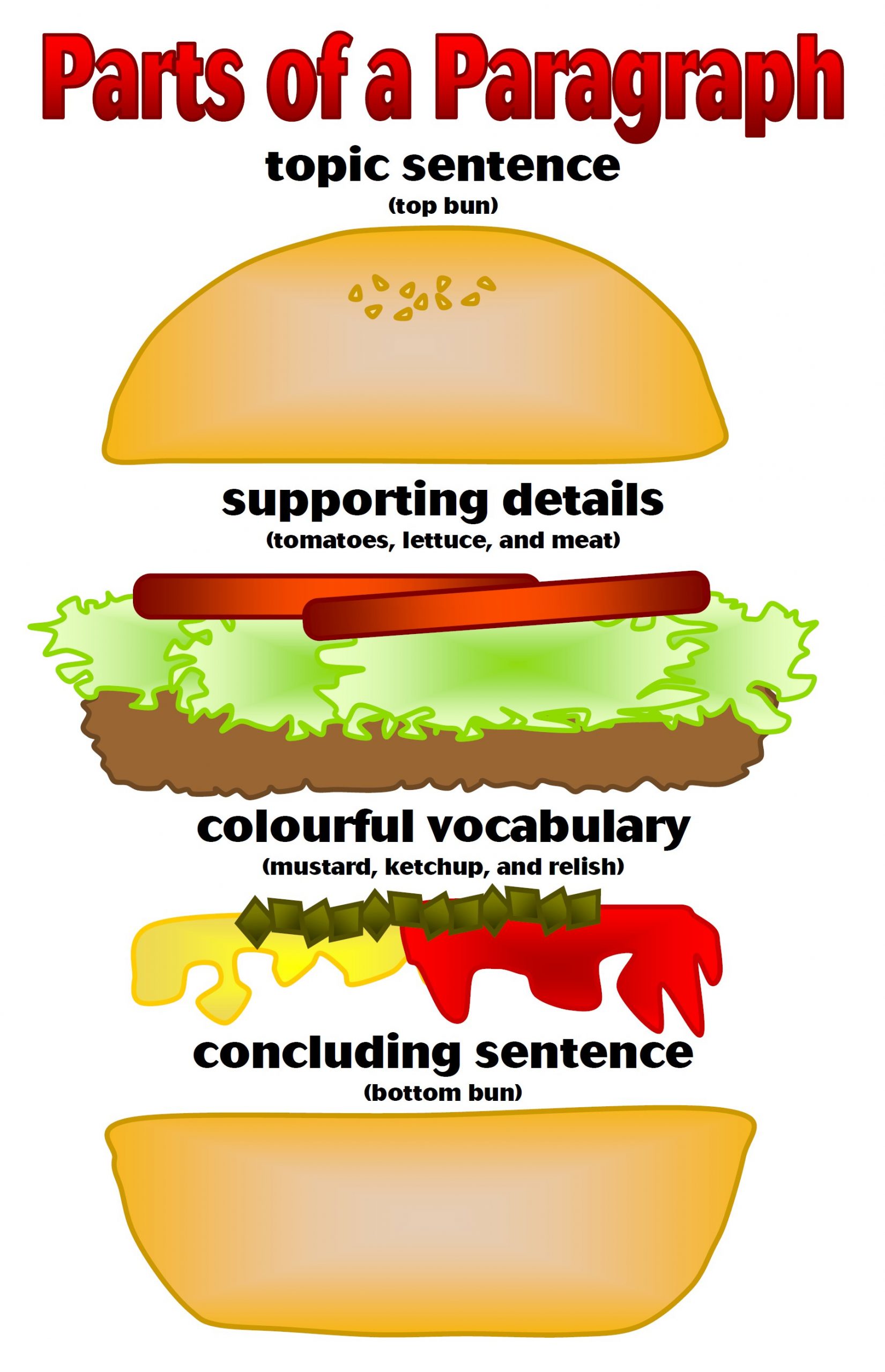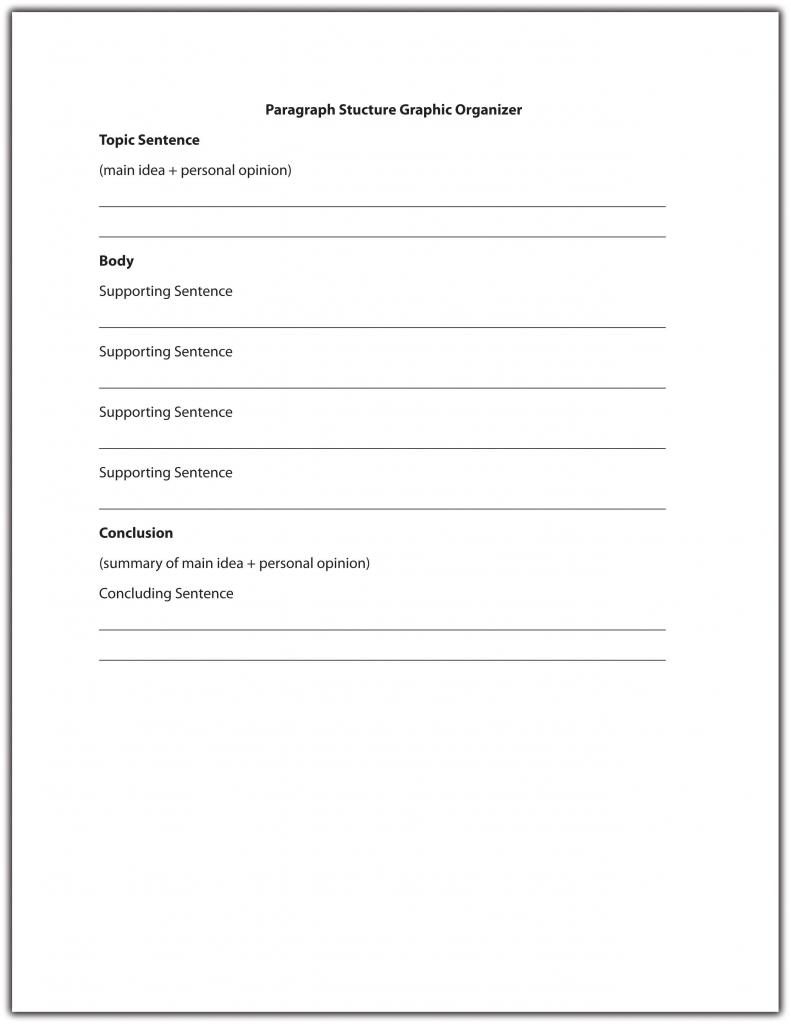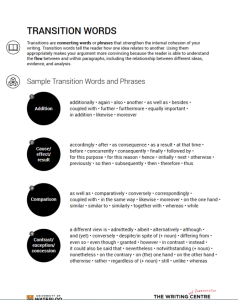2.5 – Writing Effective Paragraphs
Learning Objectives
- Producing documents, at the paragraph and project level, that meet the standards of post-secondary student writing.
- Identify components including topic sentences, supporting content, and transitional and summative sentences of structurally sound paragraphs.
- Identify characteristics of a good topic sentence.
- Identify the three parts of a developed paragraph.
- Apply knowledge of topic sentences and parts of a developed paragraph in an assignment.
Now that you have identified common purposes for writing and learned how to select appropriate content for a particular audience, you can think about the structure of a paragraph in greater detail. Composing an effective paragraph requires a method similar to building a house. You may have the finest content, or materials, but if you do not arrange them in the correct order, then the final product will not hold together very well.
A strong paragraph contains three distinct components:
- Topic sentence . The topic sentence is the main idea of the paragraph.
- Body . The body is composed of the supporting sentences that develop the main point.
- Conclusion . The conclusion is the final sentence that summarizes the main point.
The foundation of a good paragraph is the topic sentence, which expresses the main idea of the paragraph. The topic sentence relates to the thesis, or main point, of the essay (see Chapter 4 “Writing Essays: From Start to Finish” for more information about thesis statements) and guides the reader by signposting what the paragraph is about. All the sentences in the rest of the paragraph should relate to the topic sentence.
This section covers the major components of a paragraph and examines how to develop an effective topic sentence.
Developing a Topic Sentence
Pick up any newspaper or magazine and read the first sentence of an article. Are you fairly confident that you know what the rest of the article is about? If so, you have likely read the topic sentence.

An effective topic sentence combines a main idea with the writer’s personal attitude or opinion. It serves to orient the reader and provides an indication of what will follow in the rest of the paragraph. Read the following example.
This topic sentence declares a favourable position for standardizing math and English education. After reading this sentence, a reader might reasonably expect the writer to provide supporting details and facts as to why standardizing math and English education might improve student learning in many provinces. If the purpose of the essay is actually to evaluate education in only one particular province, or to discuss math or English education specifically, then the topic sentence is misleading.

Tip
When writing a draft of an essay, allow a friend or colleague to read the opening line of your first paragraph. Ask your reader to predict what your paper will be about. If he or she is unable to guess your topic accurately, you should consider revising your topic sentence so that it clearly defines your purpose in writing.
Main Idea versus Controlling Idea
Topic sentences contain both a main idea (the subject, or topic that the writer is discussing) and a controlling idea (the writer’s specific stance on that subject). Just as a thesis statement includes an idea that controls a document’s focus (as you will read about in Chapter 3 “The Writing Process: How Do I Begin?”), a topic sentence must also contain a controlling idea to direct the paragraph. Different writers may use the same main idea but can steer their paragraph in a number of different directions according to their stance on the subject. Read the following examples.
- Marijuana is a destructive influence on teens and causes long-term brain damage.
- The antinausea properties in marijuana are a lifeline for many cancer patients.
- Legalized marijuana creates a higher demand for Class A and Class B drugs.
Although the main idea—marijuana—is the same in all three topic sentences, the controlling idea differs depending on the writer’s viewpoint.
Exercise 1
Circle the main idea and underline the controlling idea in each of the following topic sentences.
- Exercising three times a week is the only way to maintain good physical health.
- Sexism and racism are still rampant in today’s workplace.
- Raising the legal driving age to twenty-one would decrease road traffic accidents.
- Owning a business is the only way to achieve financial success.
- Dog owners should be prohibited from taking their pets on public beaches.
Characteristics of a Good Topic Sentence
Five characteristics define a good topic sentence:
- A good topic sentence provides an accurate indication of what will follow in the rest of the paragraph.
Weak example. People rarely give firefighters the credit they deserve for such a physically and emotionally demanding job. (The paragraph is about a specific incident that involved firefighters; therefore, this topic sentence is too general.)
Stronger example. During the October riots, Unit 3B went beyond the call of duty. (This topic sentence is more specific and indicates that the paragraph will contain information about a particular incident involving Unit 3B.)
- A good topic sentence contains both a topic and a controlling idea or opinion.
Weak example. In this paper, I am going to discuss the rising suicide rate among young professionals. (This topic sentence provides a main idea, but it does not present a controlling idea, or thesis.)
Stronger example. The rising suicide rate among young professionals is a cause for immediate concern. (This topic sentence presents the writer’s opinion on the subject of rising suicide rates among young professionals.)
- A good topic sentence is clear and easy to follow.
Weak example. In general, writing an essay, thesis, or other academic or nonacademic document is considerably easier and of much higher quality if you first construct an outline, of which there are many different types. (This topic sentence includes a main idea and a controlling thesis, but both are buried beneath the confusing sentence structure and unnecessary vocabulary. These obstacles make it difficult for the reader to follow.)
Stronger example. Most forms of writing can be improved by first creating an outline. (This topic sentence cuts out unnecessary verbiage and simplifies the previous statement, making it easier for the reader to follow.)
- A good topic sentence does not include supporting details.
Weak example. Salaries should be capped in baseball for many reasons, most importantly so we don’t allow the same team to win year after year. (This topic sentence includes a supporting detail that should be included later in the paragraph to back up the main point.)
Stronger example. Introducing a salary cap would improve the game of baseball for many reasons. (This topic sentence omits the additional supporting detail so that it can be expanded upon later in the paragraph.)
- A good topic sentence engages the reader by using interesting vocabulary.
Weak example. The military deserves better equipment. (This topic sentence includes a main idea and a controlling thesis, but the language is bland and unexciting.)
Stronger example. The appalling lack of resources provided to the military is outrageous and requires our immediate attention. (This topic sentence reiterates the same idea and controlling thesis, but adjectives such as appalling and immediate better engage the reader. These words also indicate the writer’s tone.)
Video Source: Scribbr. (2020, February 3). How to write a topic sentence [Video]. YouTube. https://www.youtube.com/watch?v=2R-9T9TgGnE
Test Yourself
Read each of the examples below, and decide whether it is a strong or weak topic sentence based on the criteria listed above. Then click on the sentence to find out if you are on the right track.
Activity Source: “Is the topic sentence WEAK or STRONG?” by Emily Cramer is licensed under CC BY-NC 4.0.
Exercise 2
Choose the most effective topic sentence from the following sentence pairs.
- a. This paper will discuss the likelihood of the Democrats winning the next election.
b. To boost their chances of winning the next election, the Democrats need to listen to public opinion.
- a. The unrealistic demands of union workers are crippling the economy for three main reasons.b. Union workers are crippling the economy because companies are unable to remain competitive as a result of added financial pressure.
- a. Authors are losing money as a result of technological advances.b. The introduction of new technology will devastate the literary world.
- a. Rap music is produced by untalented individuals with oversized egos.b. This essay will consider whether talent is required in the rap music industry.
Exercise 3
Using the tips on developing effective topic sentences in this section, create a topic sentence on each of the following subjects. Remember to include a controlling idea as well as a main idea. Write your responses on your own sheet of paper.
- An endangered species
- The cost of fuel
- The legal drinking age
- A controversial film or novel
Writing at Work
When creating a workplace document, use the “top-down” approach—keep the topic sentence at the beginning of each paragraph so that readers immediately understand the gist of the message. This method saves busy colleagues precious time and effort trying to figure out the main points and relevant details.
Headings are another helpful tool. In a text-heavy document, break up each paragraph with individual headings. These serve as useful navigation aids, enabling colleagues to skim through the document and locate paragraphs that are relevant to them.
Developing Paragraphs That Use Topic Sentences, Supporting Ideas, and Transitions Effectively

Learning how to develop a good topic sentence is the first step toward writing a solid paragraph. Once you have composed your topic sentence, you have a guideline for the rest of the paragraph. To complete the paragraph, a writer must support the topic sentence with additional information and summarize the main point with a concluding sentence.
This section identifies the three major structural parts of a paragraph and covers how to develop a paragraph using transitional words and phrases.
Identifying Parts of a Paragraph
An effective paragraph contains three main parts: a topic sentence, the body, and the concluding sentence. A topic sentence is often the first sentence of a paragraph. This chapter has already discussed its purpose—to express a main idea combined with the writer’s attitude about the subject. The body of the paragraph usually follows, containing supporting details. Supporting sentences help explain, prove, or enhance the topic sentence. The concluding sentence is the last sentence in the paragraph. It reminds the reader of the main point by restating it in different words.
Figure 2.2 Paragraph Structure Graphic Organizer

Read the following paragraph. The topic sentence (the first one in the paragraph) is underlined for you.
It tells the reader that the paragraph will be about reality television shows, and it expresses the writer’s distaste for these shows through the use of the word bombarded.
Each of the following sentences in the paragraph supports the topic sentence by providing further information about a specific reality television show. The final sentence is the concluding sentence. It reiterates the main point that viewers are bored with reality television shows by using different words from the topic sentence.
Paragraphs that begin with the topic sentence move from the general to the specific. They open with a general statement about a subject (reality shows) and then discuss specific examples (the reality show Prisoner). Most academic essays contain the topic sentence at the beginning of the first paragraph.
Now take a look at the following paragraph. The topic sentence is underlined for you.
The last sentence of this paragraph, “Compared to many animals, our own senses are almost dull.”, is the topic sentence. It draws on specific examples (a cat that tracked down its owners and a dog that can predict seizures) and then makes a general statement that draws a conclusion from these examples (animals’ senses are better than humans’). In this case, the supporting sentences are placed before the topic sentence and the concluding sentence is the same as the topic sentence.
This technique is frequently used in persuasive writing. The writer produces detailed examples as evidence to back up his or her point, preparing the reader to accept the concluding topic sentence as the truth.
Sometimes, the topic sentence appears in the middle of a paragraph. Read the following example. The topic sentence is underlined for you.
In this paragraph, the underlined sentence, “Last year, I was referred to a specialist and finally found a way to control my anxiety – breathing exercises.”, is the topic sentence. It expresses the main idea—that breathing exercises can help control anxiety. The preceding sentences enable the writer to build up to his main point (breathing exercises can help control anxiety) by using a personal anecdote (how he used to suffer from anxiety). The supporting sentences then expand on how breathing exercises help the writer by providing additional information. The last sentence is the concluding sentence and restates how breathing can help manage anxiety.
Placing a topic sentence in the middle of a paragraph is often used in creative writing. If you notice that you have used a topic sentence in the middle of a paragraph in an academic essay, read through the paragraph carefully to make sure that it contains only one major topic. To read more about topic sentences and where they appear in paragraphs, see Chapter 3 “The Writing Process: How Do I Begin?”.
Exercise 4
Identify the topic sentence, supporting sentences, and concluding sentence in the following paragraph.
The desert provides a harsh environment in which few mammals are able to adapt. Of these hardy creatures, the kangaroo rat is possibly the most fascinating. Able to live in some of the most arid parts of the southwest, the kangaroo rat neither sweats nor pants to keep cool. Its specialized kidneys enable it to survive on a minuscule amount of water. Unlike other desert creatures, the kangaroo rat does not store water in its body but instead is able to convert the dry seeds it eats into moisture. Its ability to adapt to such a hostile environment makes the kangaroo rat a truly amazing creature.
Collaboration
Please share with a classmate and compare your answers.
Supporting Sentences
If you think of a paragraph as a hamburger, the supporting sentences are the meat inside the bun. They make up the body of the paragraph by explaining, proving, or enhancing the controlling idea in the topic sentence. Most paragraphs contain three to six supporting sentences depending on the audience and purpose for writing. A supporting sentence usually offers one of the following:
- Reason Sentence: The refusal of the baby boom generation to retire is contributing to the current lack of available jobs.
- Fact
Sentence: Many families now rely on older relatives to support them financially.
- Statistic
Sentence: Nearly 10 percent of adults are currently unemployed in the United States.
- Quotation Sentence: “We will not allow this situation to continue,” stated Senator Johns.
- Example Sentence: Last year, Bill was asked to retire at the age of fifty-five.
The type of supporting sentence you choose will depend on what you are writing and why you are writing. For example, if you are attempting to persuade your audience to take a particular position you should rely on facts, statistics, and concrete examples, rather than personal opinions. Read the following example:
There are numerous advantages to owning a hybrid car. (Topic sentence)
First, they get 20 percent to 35 percent more miles to the gallon than a fuel-efficient gas-powered vehicle. (Supporting sentence 1: statistic)
Second, they produce very few emissions during low speed city driving. (Supporting sentence 2: fact)
Because they do not require gas, hybrid cars reduce dependency on fossil fuels, which helps lower prices at the pump. (Supporting sentence 3: reason)
Alex bought a hybrid car two years ago and has been extremely impressed with its performance. (Supporting sentence 4: example)
“It’s the cheapest car I’ve ever had,” she said. “The running costs are far lower than previous gas powered vehicles I’ve owned.” (Supporting sentence 5: quotation)
Given the low running costs and environmental benefits of owning a hybrid car, it is likely that many more people will follow Alex’s example in the near future. (Concluding sentence)
To find information for your supporting sentences, you might consider using one of the following sources:
- Reference book
- Website
- Biography/autobiography
- Map
- Dictionary
- Newspaper/magazine
- Interview
- Previous experience
- Personal research
Tip
When searching for information on the Internet, remember that some websites are more reliable than others. Websites ending in .gov or .edu are generally more reliable than websites ending in .com or .org. Wikis and blogs are not reliable sources of information because they are subject to inaccuracies.
Concluding Sentences
An effective concluding sentence draws together all the ideas you have raised in your paragraph. It reminds readers of the main point—the topic sentence—without restating it in exactly the same words. Using the hamburger example, the top bun (the topic sentence) and the bottom bun (the concluding sentence) are very similar. They frame the “meat” or body of the paragraph. Compare the topic sentence and concluding sentence from the previous example:
Topic sentence: There are numerous advantages to owning a hybrid car.
Concluding sentence: Given the low running costs and environmental benefits of owning a hybrid car, it is likely that many more people will follow Alex’s example in the near future.
Notice the use of the synonyms advantages and benefits. The concluding sentence reiterates the idea that owning a hybrid is advantageous without using the exact same words. It also summarizes two examples of the advantages covered in the supporting sentences: low running costs and environmental benefits.
You should avoid introducing any new ideas into your concluding sentence. A conclusion is intended to provide the reader with a sense of completion. Introducing a subject that is not covered in the paragraph will confuse the reader and weaken your writing.
A concluding sentence may do any of the following:
- Restate the main idea.
Example: Childhood obesity is a growing problem in Canada.
- Summarize the key points in the paragraph.
Example: A lack of healthy choices, poor parenting, and an addiction to video games are among the many factors contributing to childhood obesity.
- Draw a conclusion based on the information in the paragraph.
Example: These statistics indicate that unless we take action, childhood obesity rates will continue to rise.
- Make a prediction, suggestion, or recommendation about the information in the paragraph.
Example: Based on this research, more than 60 percent of children in Canada will be morbidly obese by the year 2030 unless we take evasive action.
- Offer an additional observation about the controlling idea.
Example: Childhood obesity is an entirely preventable tragedy.
Exercise 5
On your own paper, write one example of each type of concluding sentence based on a topic of your choice.
Transitions
A strong paragraph moves seamlessly from the topic sentence into the supporting sentences and on to the concluding sentence. To help organize a paragraph and ensure that ideas logically connect to one another, writers use transitional words and phrases. A transition is a connecting word that describes a relationship between ideas. Take another look at the earlier example:
Each of the underlined words (first, second and because) is a transition word. Words such as first and second are transition words that show sequence or clarify order. They help organize the writer’s ideas by showing that he or she has another point to make in support of the topic sentence. Other transition words that show order include third, also, and furthermore.
The transition word because is a transition word of consequence that continues a line of thought. It indicates that the writer will provide an explanation of a result. In this sentence, the writer explains why hybrid cars will reduce dependency on fossil fuels (because they do not require gas). Other transition words of consequence include as a result, so that, since, or for this reason.
To include a summarizing transition in her concluding sentence, the writer could rewrite the final sentence as follows:
The following lists provide some useful transition words to connect supporting sentences and concluding sentences. See “Transition Words” from the University of Waterloo for a more comprehensive look at transitional words and phrases.
Examples of transition words
For Supporting Sentences:
- above all, but, for instance, in particular, moreover, subsequently, also, conversely, furthermore, later on, nevertheless, therefore, aside from, correspondingly, however, likewise, on one hand, to begin with, at the same time, for example, in addition, meanwhile, on the contrary…
For Concluding sentences:
- after all, all things considered, in brief, in summary, on the whole, to sum up, all in all, finally, in conclusion, on balance, thus…
Transition Words Use
This worksheet will guide you on the use of transition words in your writing.

“Transition Words” by the “Writing and Communication Centre” at the University of Waterloo licensed under CC by SA 4.0.
Exercise 6
Using your own paper, write a paragraph on a topic of your choice. Be sure to include a topic sentence, supporting sentences, and a concluding sentence and to use transitional words and phrases to link your ideas together.
Writing at Work
Transitional words and phrases are useful tools to incorporate into workplace documents. They guide the reader through the document, clarifying relationships between sentences and paragraphs so that the reader understands why they have been written in that particular order.
For example, when writing an instructional memo, it may be helpful to consider the following transitional words and phrases: before you begin, first, next, then, finally, after you have completed. Using these transitions as a template to write your memo will provide readers with clear, logical instructions about a particular process and the order in which steps are supposed to be completed
Key Takeaways
- A good paragraph contains three distinct components: a topic sentence, body, and concluding sentence.
- The topic sentence expresses the main idea of the paragraph combined with the writer’s attitude or opinion about the topic.
- Good topic sentences contain both a main idea and a controlling idea, are clear and easy to follow, use engaging vocabulary, and provide an accurate indication of what will follow in the rest of the paragraph.
- Topic sentences may be placed at the beginning, middle, or end of a paragraph. In most academic essays, the topic sentence is placed at the beginning of a paragraph.
- Supporting sentences help explain, prove, or enhance the topic sentence by offering facts, reasons, statistics, quotations, or examples.
- Concluding sentences summarize the key points in a paragraph and reiterate the main idea without repeating it word for word.
- Transitional words and phrases help organize ideas in a paragraph and show how these ideas relate to one another.
Attributions & References
Except where otherwise noted, this chapter is adapted from “6.2 Effective means for writing a paragraph” In Writing for Success by University of Minnesota licensed under CC BY-NC 4.0. / Adaptations include updates for accessibility and images for visual appeal.

